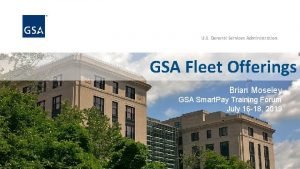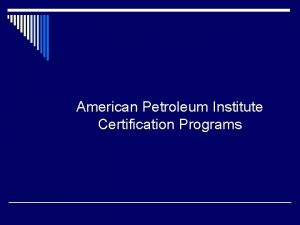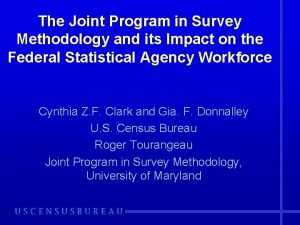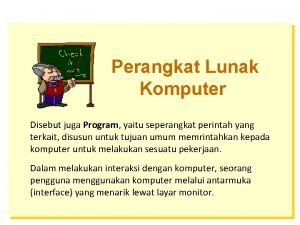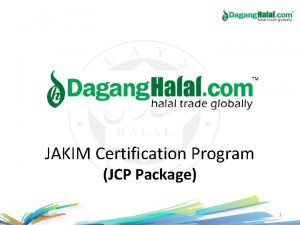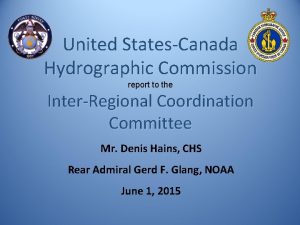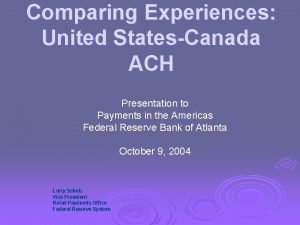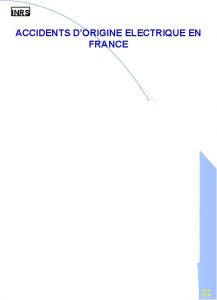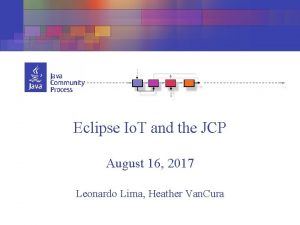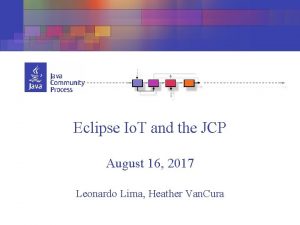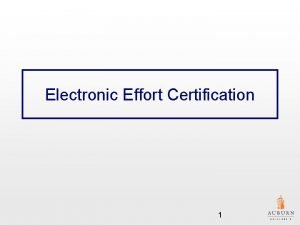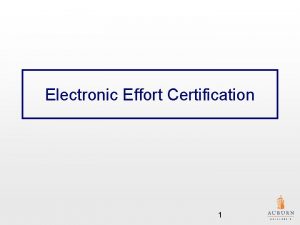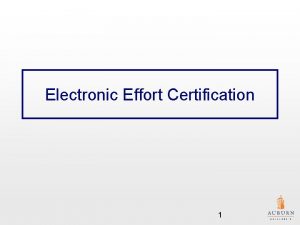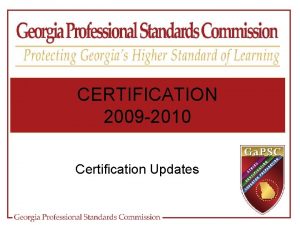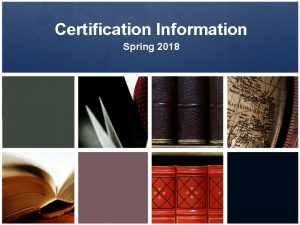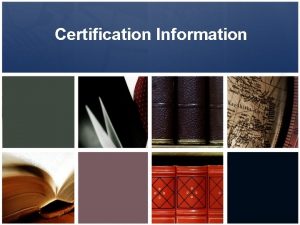United StatesCanada Joint Certification Program JCP What is




















- Slides: 20

United States/Canada Joint Certification Program (JCP)

What is the U. S. /Canada Joint Certification Program and why does my company need a certification? • The JCP was established in 1985 to allow United States (U. S. )/Canadian contractors to apply for access to Department of Defense/Department of National Defence (DOD/DND) unclassified export controlled technical data/critical technology on an equally favorable basis. • Certification under the JCP establishes the eligibility of a U. S. or Canadian contractor to technical data governed, in the U. S. , by DODI 5320. 25 and, in Canada, by the Technical Data Control Regulations (TDCR) • A certification is required by U. S. or Canadian contractors that wish to obtain access to unclassified technical data disclosing militarily critical technology with military or space application that is under the control of, or in the possession of the U. S. DOD or the Canadian Department of National Defence (DND) ØThe bottom line: In beta. SAM some Contract Opportunities have attachments that are marked as “CONTROLLED” access. JCP certification is required to view these attachments. Without the JCP certification your company will be denied access.

The Joint Certification Program (JCP) is administered by the Defense Logistics Agency. The correct link for the current JCP site: https: //www. dla. mil/HQ/Logistics. Operations/Services/JCP/

In beta. SAM some Contract Opportunities have attachments that are marked as “CONTROLLED” access. If your company is interested in gaining access to view the attachments, your company must be approved by the JCP program in advance. If your company is not certified access will be denied.

If you wish to find out if your company is certified use “JCP search” at this link: https: //public. logisticsinformationservice. dla. mil/jcp/ search. aspx To be ready to search you will need one of the following: 1. Certification Number, or 2. Partial company name (must have at least 3 characters, or 3. State/Province (must have at least 2 characters, or 4. CAGE/NCAGE, or 5. Partial Organization Name

If your company is not JCP certified, the DD Form 2345 will need to be submitted, processed. A certification number will be issued by the JCP if your company is approved. To view the form instructions: https: //www. dla. mil/HQ/Logistics. Operations/Service s/JCP/Specific. DD 2345 Instructions. aspx Additional documentation will be required when submitting the request. NOTE: If you are going to do business with the Defense Logistics Agency (DLA) additional certification steps are required. The certification for your company may take several weeks/months to be processed.

Your company must submit a completed DD Form 2345 to become JCP certified. Consider these points when completing the form: Sample of the DD 2345 DD Form 2345: • The individual listed in block 3 A is the single Data Custodian for your company • The Data Custodian is the only one who may be granted access to view drawings for the solicitation • If the approved Data Custodian leaves the company, the JCP certification becomes invalid and a new DD Form 2345 must be submitted • If the Data Custodian legally changes any portion of their name a new DD Form 2345 must be submitted • The Certifying Contractor in block 6 may not be granted access in lieu of the Data Custodian • If the company is a large company, then a Data Custodian may be assigned per location. Each location will require a DD Form 2345 be submitted and certified https: //www. esd. whs. mil/Portals/54/Documents/DD/forms/dd/dd 2345. pdf

When ready, submit as stated. This form requires a “hard copy” signature. JCP no longer accepts a faxed form. Processing time varies depending upon many factors. If possible, submit via email for quicker service. NOTE: If you are going to do business with the Defense Logistics Agency (DLA) additional certification steps are required. The certification for your company may take several weeks/months to be processed.

Things to know when dealing with Do. D Export-Controlled Documents

The information on the following slides is intended to help you understand what you should do when dealing with Do. D export-controlled data/documents of any type. The information is a guideline, here’s what we’ll cover: 1. 2. 3. 4. 5. 6. 7. Understanding Do. D Distribution Statements Arms Export Control Act (AECA) Export Control Reform (ECR) Defining Do. D export-controlled data/documents Penalties for violating export-control laws and regulations Understanding and notification of Export Control Compliance Certification statement of Export Control Compliance NOTE: This information is for introductory awareness only and does not take precedence over the regulatory requirements, instructions or directions proscribed by the Department of State or Department of Commerce. Where information is unclear, conflicts or further clarification is required, individuals should consult the Directorate of Defense Trade Controls at: https: //www. pmddtc. state. gov/? id=ddtc_public_portal_contact_us for ITAR related inquiries OR the Bureau of Industry and Security at: https: //www. bis. doc. gov/index. php/about-bis/contactbisforinquiresrelatedtothe. Export. Administration. Regulations

What is a DISTRIBUTION STATEMENT? • Establishes a standard framework and markings for managing, sharing, safeguarding, and disseminating technical data/documents in accordance with policy and law. • Enables document originators (controlling Do. D Office) to signify to what extent technical documents must be controlled. How do I know if it applicable to the documents I’m accessing/using? • Newly created, revised, or previously unmarked classified and unclassified technical data/documents generated or managed by all Do. D-funded research, development, test, and evaluation (RDT&E) programs, which are the basis of the Do. D Scientific and Technical Information Program • Newly created engineering drawings, engineering data and associated lists, standards, specifications, technical manuals, technical reports, technical orders, blueprints, plans, instructions, computer software and documentation, catalog-item identifications, data sets, studies and analyses, and other technical information that can be used or be adapted for use to design, engineer, produce, manufacture, operate, repair, overhaul, or reproduce any military or space equipment or technology concerning such equipment. �NOTE: The data may be in tangible form, such as a model, prototype, blueprint, photograph, plan, instruction, or an operating manual, or may be intangible, such as a technical service or oral, auditory, or visual descriptions.

What does a Distribution Statement code mean? All newly created, revised, or previously unmarked classified and unclassified Do. D technical documents shall be assigned Distribution Statement A, B, C, D, E, or F DISTRIBUTION STATEMENTS Defined: • DISTRIBUTION STATEMENT A: Approved for public release. Distribution is unlimited. • DISTRIBUTION STATEMENT B: Distribution authorized to U. S. Government agencies only. Other requests for this document shall be referred to (insert controlling Do. D office) • DISTRIBUTION STATEMENT C: Distribution authorized to U. S. Government agencies and their contractors (fill in reason) (date of determination). Other requests for this document shall be referred to (insert controlling Do. D office). • DISTRIBUTION STATEMENT D: Distribution authorized to the Department of Defense and U. S. Do. D contractors only (fill in reason) (date of determination). Other requests shall be referred to (insert controlling Do. D office). • DISTRIBUTION STATEMENT E: Distribution authorized to Do. D Components only (fill in reason) (date of determination). Other requests shall be referred to (insert controlling Do. D office) • DISTRIBUTION STATEMENT F: Further dissemination only as directed by (inserting controlling Do. D office) (date of determination) or higher Do. D authority. ” Distribution Statement F may be applied under rare and exceptional circumstances when specific authority exists or when need-to-know must be verified.

Distribution Statements Continued: • EXPORT CONTROL WARNING. All printed and electronic, including digital, technical documents that are determined to contain export-controlled technical data shall be marked with an export control warning. When it is technically infeasible to use the entire statement, an abbreviated marking may be used, and a copy of the full statement added to the “Notice To Accompany Release of Export-Controlled Data” �Note: While publications are being updated, export control warning statements may still reference the Export Administration Act of 1979 (Title 50 USC, App. 2401 et seq. ) versus the new enactment of Export Control Reform (Title 50 USC, 4801 -4851). �For additional information related to Distribution Statements please refer to Do. D Instruction 5230. 24 https: //www. esd. whs. mil/Portals/54/Documents/DD/issuances/dodi/523024 p. pdf? ver=2018 -11 -08120712090

What is the Arms Export Control Act? • Arms Export Control Act (AECA, 22 USC § 2778) q Provides the authority to control the export of defense articles and services, and charges the President to exercise this authority. Executive Order 13637 delegates this statutory authority to the Secretary of State. • International Traffic in Arms Regulations (ITAR, 22 CFR § 120 -130) q Implements the authorities of the AECA. These regulations are regularly updated and revised to reflect change in the international political and security climate, as well as technological development. • United States Munitions List (USML, 22 CFR § 121) q Articles, services, and related technical data that are designated as defense articles or defense services pursuant to sections 38 and 47(7) of the AECA constitute the USML. • Directorate of Defense Trade Controls (DDTC) q The Directorate of Defense Trade Controls (DDTC), Bureau of Political-Military Affairs, in accordance with 22 U. S. C. § 2778 -2780 of the AECA and the ITAR (22 CFR § 120130), is charged with controlling the export and temporary import of defense articles and defense services covered by the USML.

What is Export Control Reform? • Export Control Reform (ECR, 50 USC § 4801 -4851) q Provide authority to regulate exports, to improve the efficiency of export regulation, and to minimize interference with the ability to engage in commerce. • Export Administration Regulation (EAR, 15 CFR § 730 -774) q Regulations set forth in parts 730 -774, inclusive, of Title 15 of the Code of Federal Regulations, designed primarily to implement Export Control Reform. q The EAR are issued by the United States Department of Commerce, Bureau of Industry and Security (BIS) under laws relating to the control of certain exports, reexports, and activities. • Commerce Control List (CCL, 15 CFR§ 774) q A list of items under the export control jurisdiction of the Bureau of Industry and Security, U. S. Department of Commerce. Note that certain additional items described in part 732 of the EAR are also subject to the EAR. The CCL is found in Supplement No. 1 to part 774 of the EAR.

Do. D Export-Controlled Technical Data is: • Recorded information, regardless of the form or method of the recording, of a scientific or technical nature (including computer software documentation) that is subject to U. S. Federal export control regulations under the jurisdiction of the Department of State (Do. S) as [Technical Data, 22 CFR§ 120. 10] and Department of Commerce (Do. C) as [Technology, 15 CFR§ 772. 1]. The term does not include computer software or data incidental to contract administration, such as financial and/or management information. • All Transfers of Do. D export-controlled technical data must be conducted in accordance with U. S. Federal export-control regulations.

Transfer Requirements and Control for Do. D Export-Controlled Technical Data: • Transfers of Do. D export-controlled technical data by purchasers, bidders, or transferees are subject to the requirements of the appropriate licensing department or agency. In many cases, an export license or other authorization may be required prior to transfer. • With respect to Do. D export-controlled technical data covered under the USML, registration of the purchaser's, bidder's, transferee's business with the Do. S may also be required. It is the responsibility of the purchaser, bidder, transferee to determine what the applicable requirements may be and to obtain all necessary authorization or approvals. • Controls Tangible / Intangible Transfers. The United States and other key supplier countries control the transfer of "technology" not in the public domain that is necessary for the development, production, or use of controlled commodities in the same ways that controls are maintained on transfers of the commodities themselves. Furthermore, the United States makes no legal distinction between "tangible" and "intangible" transfers of controlled technology, the form that the technology takes and the means of transfer is not relevant. q These U. S. Federal export-controls also cover all forms of transfer, including emails, faxes, and face-to-face conversations. Under U. S. law, providing controlled technology to a foreign person, whether within the U. S. or not, is deemed to be equivalent to physically exporting that technology to the country of the person's nationality.

Penalties for Violating the AECA: • AECA (22 USC § 2778(c) Criminal violations; punishment) q Any person who willfully violates any provision of this section, section 2779 of this title, a treaty referred to in subsection (j)(1)(C)(i), or any rule or regulation issued under this section or section 2779 of this title, including any rule or regulation issued to implement or enforce a treaty referred to in subsection (j)(1)(C)(i) or an implementing arrangement pursuant to such treaty, or who willfully, in a registration or license application or required report, makes any untrue statement of a material fact or omits to state a material fact required to be stated therein or necessary to make the statements therein not misleading, shall upon conviction be fined for each violation not more than $1, 000 or imprisoned not more than 20 years, or both.

Penalties for Violating the ECR: • ECR (50 USC § 4819 (b) Criminal Penalty) q A person who willfully commits, willfully attempts to commit, or willfully conspires to commit, or aids and abets in the commission of, an unlawful act described in subsection (a)(1) shall be fined not more than $1, 000; and (2) in the case of the individual, shall be imprisoned for not more than 20 years, or both. • ECR (50 USC § 4819 (c) Civil Penalty) q Authority: The Secretary may impose the following civil penalties on a person for each violation by that person of this subchapter or any regulation, order, or license issued under this subchapter, for each violation: (A) A fine of not more than $300, 000 or an amount that is twice the value of the transaction that is the basis of the violation with respect to which the penalty is imposed, whichever is greater. (B) Revocation of a license issued under this subchapter to the person. (C) A prohibition on the person's ability to export, reexport, or in-country transfer any items controlled under this subchapter.

Understanding and Notifications: 1. The use, disposition, export and re-export of this property is subject to all applicable U. S. Laws and Regulations, including but not limited to the Arms Export Control Act (22 USC 2751 et seq. ); Export Control Reform (50 USC 4801 -4851); Executive Order 13222, as amended; International Traffic in Arms Regulations (22 CFR 120 et seq. ); Export Administration Regulations (15 CFR 730 et seq. ); Foreign Assets Control Regulations (31 CFR 500 et seq. ) and the Espionage Act (18 USC 793 et seq. ); which, among other things, prohibit: a) The making of false statements and concealment of any material information regarding the use or disposition, export or re-export of the property and b) Any use, disposition, export or re-export of the property not permitted by applicable statute and regulation. 2. The submission of false or misleading information and/or concealment of any material facts regarding the use, disposition or export of this property may constitute a violation of provisions of 18 USC 793/1001, 22 USC 2778/2779, 50 USC 4819. Sanctions for violations will be in conformity with U. S laws and regulations (including Federal Acquisition Regulations and Do. DI 2030. 08) and may include the denial of U. S. export privileges and of any participation in future U. S. Government contracts. 3. Transfers of USML and CCLI property by purchasers/bidders/transferees are subject to the requirements of the appropriate licensing department or agency. In many cases, an export license or other authorization may be required. With respect to USML, registration of the purchaser's/bidder's/ transferee's business with the Department of the State may also be required. It is the responsibility of the purchaser/bidder/transferee to determine what the applicable requirements may be and to obtain all necessary authorization or approvals. 4. When USML/CCLI property is transferred, the information in this form regarding the above laws and regulations must be passed to the subsequent purchaser/receiver. Records of Resale in buyer's possession should be available for Trade Security Controls Office review, if requested. 5. The DD 2345 number, Invitation For Bid and Sale/Exchange Contract number can be referenced when submitting an application for an export license or other authorization to the Department of State for USML or Department of Commerce for CCLI. 6. The Government expects the Purchaser/Recipient to cooperate with all authorized Government representatives to verify the existence and condition of USML/CCLI.
 Jcp račice
Jcp račice Cutability
Cutability Ligamentum nuchae
Ligamentum nuchae Which joint is permanent types
Which joint is permanent types Memorandum joint venture method
Memorandum joint venture method Lamb carcass grading
Lamb carcass grading Fibrous joints
Fibrous joints United healthcare simply engaged
United healthcare simply engaged Federal fleet manager certification program
Federal fleet manager certification program Strategic context
Strategic context Lone star teacher certification
Lone star teacher certification Women's ministries leadership certification program
Women's ministries leadership certification program Lone star college alternative teacher certification program
Lone star college alternative teacher certification program Api individual certification program
Api individual certification program Women's ministries leadership certification program level 2
Women's ministries leadership certification program level 2 Joint monitoring program
Joint monitoring program Masters in survey methodology
Masters in survey methodology Differences between sequential and event-driven programming
Differences between sequential and event-driven programming Perangkat lunak komputer disebut
Perangkat lunak komputer disebut Program tahunan adalah
Program tahunan adalah Microsoft excel merupakan aplikasi
Microsoft excel merupakan aplikasi








